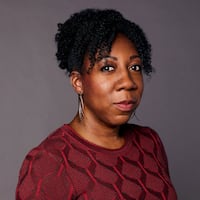Mother Mathilda Beasley died in 1903 in a small cottage owned by a Catholic church. She was worshipping at an altar she had built inside, and lying next to her were burial clothes, a will and instructions for her funeral.
The details of her death stand in stark contrast to the many things that aren’t known about the life of Georgia’s first black nun.
It’s unknown how Beasley, who was born into slavery in New Orleans and whose father was likely Native American, obtained her freedom.
And it’s unknown how she made her way to Savannah.
But it is known that she risked severe punishment, and perhaps her own liberty, to operate a secret school to teach black children how to read and write. The school was open in the 1850s at a time when it was illegal to educate black children.
»MORE: ‘Lift Every Voice and Sing’: Whether anthem or hymn, song invokes pride
“We just have very little information about who was brave enough to run those schools, but we know that she ran one,” said Gail Langer Karwoski, an author and researcher near Athens.
At the time, Beasley was Mathilda Taylor. In the 1860s, she met wealthy businessman Abraham Beasley. They eventually married and ran a restaurant in the heart of Savannah.
Credit: Courtesy of Georgia Historical Society
Credit: Courtesy of Georgia Historical Society
»MORE: At Tuskegee, U.S. experimented on black men with syphilis for 40 years
When her husband died in 1877, Beasley inherited his substantial wealth — and she gave it away to the Roman Catholic Church. Why she did this is unknown. Perhaps it was to atone for Abraham Beasley’s success in trading slaves.Whatever the reason, she also asked that some of the money to be used for a home for orphaned black children, like she once was.
It was illegal at that time for black women to become nuns, so she went to England and spent time with Franciscan nuns. When she returned to the United States, she wore a habit. And over time, all of Savannah referred to her as “Mother.”
Still, there are no records that tell when and where she took the vows that officially made her a nun.
»MORE: Who were the Oblate Sisters of Providence?
Mother Beasley eventually opened her own home for orphans and ran it with a community of black nuns that she founded.
“This was a modest, quiet woman who was doing the work that she felt she was given by a higher power,” Karwoski said.
Credit: Courtesy of the Georgia Historic
Credit: Courtesy of the Georgia Historic
Perhaps the biggest mystery surrounding Mother Beasley’s life is what she looked like. Historians say the most widely circulated pictures might not be her at all.
But whatever her appearance, the self-sacrificing, deeply pious Mother Beasley is worthy of acknowledgement in black history for all that she did to help those who were less fortunate.
Throughout February, we’ll spotlight a different African-American pioneer in the daily Living section Monday through Thursday and Saturday, and in the Metro section on Fridays and Sundays. Go to AJC.com/black-history-month for more subscriber exclusives on people, places and organizations that have changed the world, and to see videos on the African-American pioneer featured here each day.
About the Author
Keep Reading
The Latest
Featured




